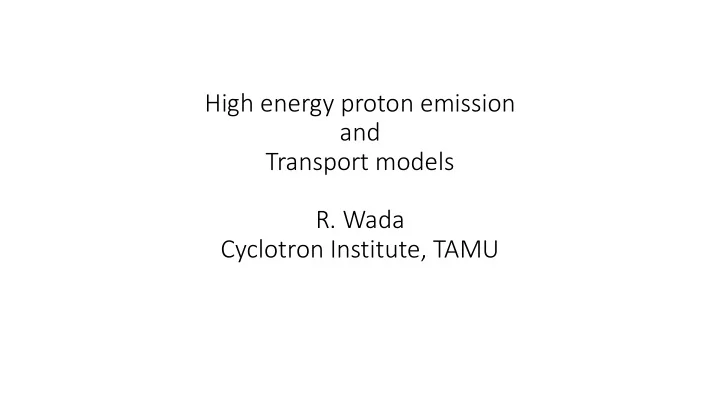

High energy proton emission and Transport models R. Wada Cyclotron Institute, TAMU
40 Ar+ 51 V @ 44 A MeV 14 o MS fit The calculations are initialized with Exp BNV x 2 BNV a sharp cut-off (270fm/c) Fermi momentum distribution and take 158 o the free NN cross section. Kinematical limit for P cutoff = 270fm/c. 72 o 160 o
Kinematical limit for P cutoff = 270fm/c. We have performed a perturbed 75 o calculation: This means that we follow the mean dynamics as given by BNV, and for each two (or three) body Collision, we calculate the Probability that the collision will create a proton of a given energy and solid angle.
12 C+ 12 C @ 94 A MeV 40 Ar+ 51 V @ 44 A MeV AMD: Initial nuclei “frozen” + 72 o quantum fluctuation (diffusion process) 160 o CoMD: Initial nuclei BE=BE_exp Fermi motion
AMD : quantum fluctuation in time evolution of wave packets (Diffusion process) A. Ono, PRC53, 2958 (1996) 40 Ar+ 51 V @ 44 A MeV Fluctuation in collision process
40 Ar+ 51 V @ 44 A MeV AMF-FM : Quantum fluctuation in collision process (r 1 ,P ’ 1 ) (r 1 ,P 1 ) 270fm/c ΔP’ > (r 2 ,P ’ 2 ) (r 1 ,P 2 ) 40 Ar+ 51 V @ 44 A MeV P i + Δ P i (i = 1,2) Momentum fluctuation is partially taken into account in the diffusion process. σ NN = σ LM
AMD-FM Apply AMD-FM at higher energy 36 Ar + 181 Ta at 94 A MeV Germain et al., Nucl. Phys. A620, 81 (1997) 3 CPU time ~ A system 40 Ar+ 51 V ~ 1 week 36 Ar+ 181 Ta ~ 13.5 weeks Up to 100 A MeV, high energy proton emission can be explained by the quantum fluctuation in the diffusion and collision process.
Higher Energy (100-400 A MeV) ?
3 body collisions in AMD-FM NN interaction mean field propagation+ NN collision term NNN interaction (mean field propagation)+ 3N collision term 3N collision term (A. Bonasera et al., Phys. Rep. 243, 1 (1994) ) 3 consecutive NN collisions At each collision, Fermi boost is taken into account in same way as AMD-FM; P' i = P i + Δ P ’ i (i = 1,2)
AMD-FM AMD-FM w/3NC ( σ NN =40mb)
Collision time and number Number of collisions vs incident energy
Summary 1. High energy proton emission below 50A MeV can be explained by AMD with a two nucleon collision term with Fermi boost together with the diffusion process. 2. 3N collisions play a significant role for the high energy proton emissions above ~100A MeV heavy ion collisions. 3 3N high energy proton production is very localized at the reaction time of high density and high temperature, and this will provide a probe for a hot-high density nuclear matter study.
Recommend
More recommend